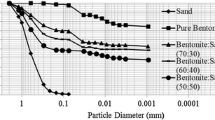Abstract
As there are many correlations linking the liquid limit directly or indirectly with various engineering properties of the soil, the accurate determination of the liquid limit is quite essential. Generally, two methods, i.e. Casagrande’s and fall cone are adopted to determine the liquid limit of soil. Research was carried out to study the influence of the properties of bentonite and the presence of the salt solution on the liquid limit values of soil-bentonite mixtures determined by the Casagrande’s and fall cone methods. The results showed that irrespective of the presence of the type of bentonite or salt solution, a higher value of the liquid limit was obtained by the Casagrande’s method as compared to the fall cone method. However, the difference between the two methods decreased with the decrease in the liquid limit, clay fraction, specific surface area and free swelling capacity of the bentonite present in the mixture. Similarly, the difference in the liquid limit values obtained by both these methods is reduced with an increase in the salt concentration.








Similar content being viewed by others
References
ASTM (2000) Standard test methods for liquid limit, plastic limit, and plasticity index of soils, D 4318. American Society for Testing and Materials, Philadelphia
ASTM (2001) Standard test method for swell index of clay mineral component of geosynthetic clay liners, D 5890. American Society for Testing and Materials, Philadelphia
ASTM (2002) Standard test method for particle-size analysis of soils, D 422–63. American Society for Testing and Materials, Philadelphia
British Standards (1990) Methods of test for soils for civil engineering purposes: classification tests 1377-2
Budhu M (1985) The effect of clay content on the liquid limit from a fall cone and British cup device. Geotech Test J 8(2):91–95
Casagrande A (1932) Research on the Atterberg limits of soils. Public Road 13(8):121–136
Casagrande A (1958) Notes on the design of the liquid limit device. Geotechnique 8(1):84–91
Cerato AB, Lutenegger AJ (2002) Determination of surface area of fine-grained soils by the ethylene glycol monoethyl ether (EGME) method. Geotech Test J 25:1–7
Deka S, Sreedeep S, Dash SK (2009) Re-evaluation of laboratory cone penetration method for high liquid limit based on free swell property of soil. Geotech Test J 32(6):553–558
Dolinar B, Trauner L (2004) Liquid limit and specific surface of clay particles. Geotech Test J 27(6):580–584
Farrar DM, Coleman JD (1967) The correlation of surface area with other properties of nineteen British clay soils. J Soil Sci 18(1):118–124
Farrell E (1997) ETC. 5 fall-cone study. Ground Eng 30(1):33–36
Hansbo S (1957) A new approach to the determination of the shear strength of clays by the fall-cone test. Proc Royal Swed Geotechn Instit 14:7–48
Karlsson R (1977) Consistency limits. Documents D6:1977
Leroueil S, Bihan JPL (1996) Liquid limits and fall cones. Can Geotech J 33:793–798
Marinho FAM (2005) Nature of soil-water characteristic curve for plastic soils. J Geotech Geoenviron Eng 131:654–661
Muhunthan B (1991) Liquid limit and surface area of clays. Geotechnique 41(1):135–138
Nagaraj TS, Srinivasamurthy BR (1983) Rationalization of Skempton’s compressibility equation. Geotechnique 33(4):433–443
Norman LEJ (1958) A comparison of values of liquid limit determined with apparatus having bases of different hardness. Geotechnique 8(2):79–83
Russel ER, Mickle JL (1970) Liquid limit values of soil moisture tensions. J Soil Mech Found Division ASCE 96:967–987
Sherwood PT, Ryley DM (1968) An examination of cone penetrometer methods for determining the liquid limit of soils. LR233, Road Research Laboratory, Crowthorne, Berkshire
Sivapullaiah PV, Sridharan A (1985) Liquid limit of soil mixtures. Geotech Test J 8(3):111–116
Sivapullaiah PV, Sridharan A, Stalin VK (2000) Hydraulic conductivity of bentonite-sand mixtures. Can Geotech J 37:406–413
Skempton AW (1944) Notes on the compressibility of clays. Q J Geol Soc Lond 100:119–135
Skopek J, Ter-Stepanian G (1975) Comparison of liquid limit values determined according to Casagrande and Vasilev. Geotechnique 25(1):135–136
Sridharan A, Prakash K (2000) Percussion and cone methods of determining the liquid limit of soils: controlling mechanisms. Geotech Test J 23(2):242–250
Sridharan A, Rao SM, Murthy NS (1986) Liquid limit of montmorilonite soils. Geotech Test J 9(3):156–159
Warkentin BP (1961) Interpretation of the upper plastic limit of clays. Nature 190:287–288
Warkentin BP, Yong RN (1962) Shear strength of montmorillonite and kaolinite related to interparticle forces. Clays Clay Miner 9:210–218
Wasti Y, Bezirci MH (1986) Determination of the consistency limits of soils by the fall cone test. Can Geotech J 23(2):241–246
Whyte IL (1982) Soil plasticity and strength—a new approach using extrusion. Ground Eng 15(1):16–24
Whyte IL (1983) Discussion. Geotechnique 33(1):76–78
Wood DM (1990) Soil behaviour and critical state soil mechanics. Cambridge University press, Cambridge
Wroth CP, Wood DM (1978) The correlation of index properties with some basic engineering properties of soils. Can Geotech J 15(2):137–145
Youssef MS, EI Ramli AH, EI Demery M (1965) Relationship between shear strength, consolidation, liquid limit and plastic limit for remoulded clays. In: Proceedings, 6th international conference on soil mechanics and foundation engineering, vol 1. pp 126–129
Author information
Authors and Affiliations
Corresponding author
Rights and permissions
About this article
Cite this article
Mishra, A.K., Ohtsubo, M., Li, L.Y. et al. Influence of various factors on the difference in the liquid limit values determined by Casagrande’s and fall cone method. Environ Earth Sci 65, 21–27 (2012). https://doi.org/10.1007/s12665-011-1061-5
Received:
Accepted:
Published:
Issue Date:
DOI: https://doi.org/10.1007/s12665-011-1061-5




